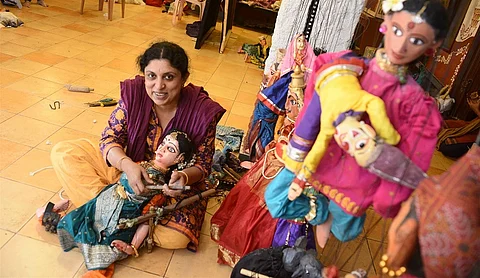

Puppet theatre tradition is as old as any other performing art cultures in India. One cannot pinpoint to any specific time as its origin, or any specific person as the founder of it. It has existed in different corners of the country since ancient times and has been a source of education and entertainment to art lovers across the spectrum.
There is the ancient ‘Tolu Bommalata’ in Andhra near Tirupathi, where colourful shadow puppets made from leather sheets. In Kerala you have the ‘Tholpava Kuthu’ tradition from the 10th century onwards. During the reign of the Chalukya king of Gujarat Tribhuvana Pala, we find references to a Sanskrit play ‘Dhutangada’ written by Subhata that mentions a shadow play by puppets and calls it ‘Chayanataka’. According to Prof. Cecil Bendal, this was staged in honour of king Kumarapala Deva who ruled Somnath in the 12th century. In Maharashtra you have the tradition of puppet theatre called ‘Chamdachya Bhuliya’. In central Indian regions like Bihar you have the tradition of ‘Yamapata’ where puppeteers sing songs and entertain audiences since the time of Pataliputra. This way there are countless references to puppet theatre traditions across India.
Outside India, countries like Thailand have the long shadow puppet theatre tradition of ‘Ramkin’. ‘Ramkin’ is basically a Thai interpretation of the Ramayana. People in Thailand identify several places and characters in the Ramayana as theirs. The puppets are called ‘Nang Yai’ puppets and shows are conducted across Thailand with much fervor. In Cambodia, the puppet theatre tradition of ‘Khmer Sbek’ has been traced to as early as 7th century. In the temple complex of Sambor Prei Kuk in Kamping Thom, you can find sculptures of female puppeteers holding small puppets. In Indonesia, you can find the Balinese shadow puppet tradition. Known as ‘Wayang’, it can be traced back to the 9th century. One can write a whole PhD thesis about puppet theatre traditions in South East Asian countries. Most of the stories narrated in traditional puppet theatre are sourced from epics like Ramayana, Mahabharata and Bhagawatam. In the recent times, puppet theatre has been a very successful medium to create social awareness in different parts of the country. Taking up social issues like illiteracy, healthcare awareness, AIDS awareness and many more, puppet theatre has been able to convey to large masses what regular theatre hasn’t.
The puppets found in Karnataka are string and rod puppets. The puppeteer needs to be skilled in making these puppets, but also be adept at handling them for a show. In addition to these, they must be masters of dealing with the puppet, its maintenance and know everything about it.
Master puppeteer Anupama Hoskere from Bengaluru owns the single largest puppet collection in India. A qualified engineer from the California State University with a Masters in Computers, she gave up her profession to pursue her passion. She founded an organization ‘Dhaatu’ in Bangalore and has been single-handedly responsible for reviving puppet theatre in that part of the country.
Anupama is also a trained Bharatanatyam dancer. Under the aegis of Dhaatu, she has conducted puppet theatre festivals across the world. Today Anupama is the proud owner of over five thousand of these toys. That makes her the single largest collector of puppets and dolls in India. She has participated in numerous puppet theatre festivals across the world and made India proud. Few years ago a documentary was made on her. A trailer of the documentary made on Anupama and her work can be seen here:
Anupama and her team at Dhaatu conduct regular workshops and festivals. Thousands of school children have enjoyed puppet theatre performances. She also employs her Bharatanatyam skills to bring in elements of dance, poetry and much more to her puppetry shows. She has done pioneering work in reviving the art form of puppetry across Karnataka. Along with stories from Ramayana, Mahabharata and Sanskrit dramas, Anupama has also directed and produced plays like ‘Silapaddikaram’ that have regaled thousands of art lovers. Anupama believes her art form has the power to instill human values and bring in the ancient wisdom to the next generation. She has been consistently working towards this.
As Dusshera and Navaratri is around the corner, hundreds of south Indian homes are preparing for the traditional ‘Golu’ or ‘Bommala Koluvu’. They display the prettiest of dolls and puppets in their collection as a part of welcoming guests home. If you are in Bangalore, check out Anupama’s vast collection of puppets and dolls at ‘Dhaatu’. If you are lucky, you can even get to witness some engaging puppet theatre. Under Anupama’s direction, watch these dolls and puppets come alive in her theatre productions. With dedicated and passionate puppeteers like Anupama Hoskere around, the rich traditional puppet theatre genre will continue to thrive more vibrant than ever before.
Images : Keshavamurthy, Dhaatu, Bangalore
(Veejay Sai is an award-winning writer, editor and a culture critic. He writes extensively on Indian performing arts, cultural history, food and philosophy. He lives in New Delhi and can be reached at vs.veejaysai@gmail.com)
Also read: